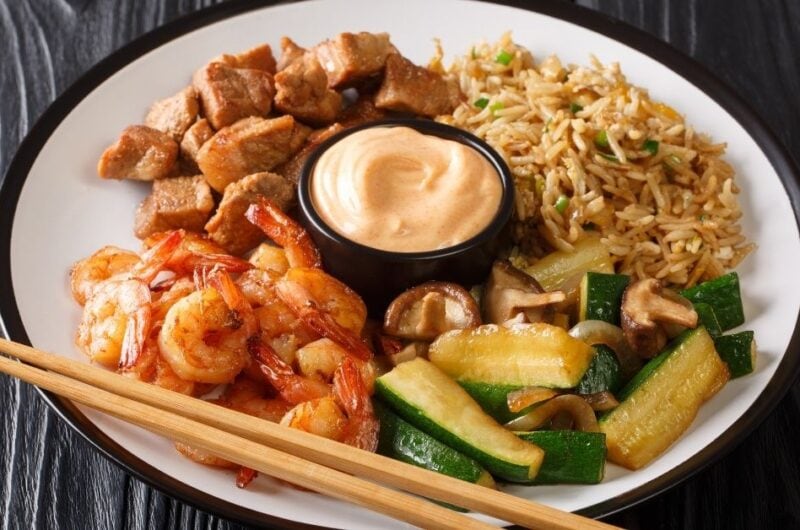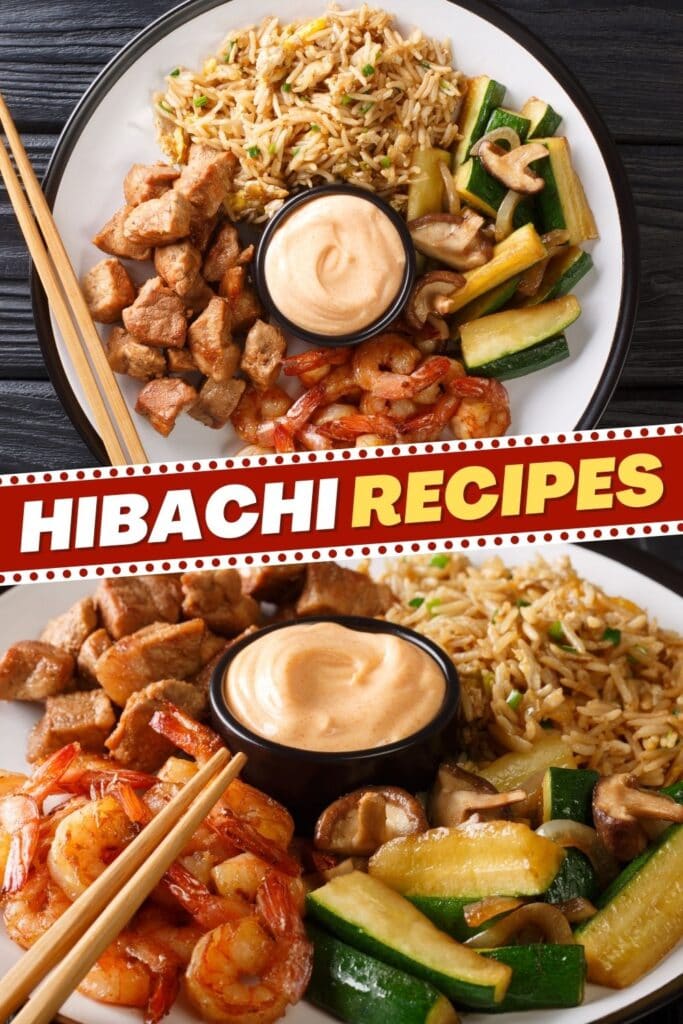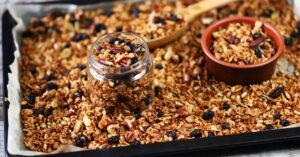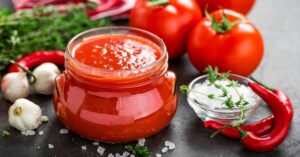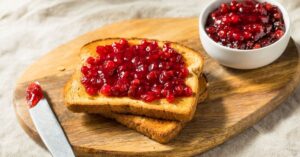This traditional Japanese cooking style involves grilling food on an open metal grate, under which you’ll find a container full of burning charcoal or wood. Cooking over an open flame is a sure-fire way to enhance your food and give it a boost of incredible smoky flavor. It’s also a fun and interactive dinner to enjoy with friends and family. So for something a little different, why not get yourself a grill and get cooking?!
1. Hibachi Shrimp
In the States, the term hibachi is often used interchangeably with teppanyaki. Unlike hibachi, though, teppanyaki uses a large flattop hot plate/grill, not a grate over charcoal. This allows chefs to cook everything from meats and veggies to rice and eggs because the plate is solid. With that in mind, many of these hibachi recipes are technically teppanyaki recipes. So, instead of a grill over a flame, you can use an electric griddle or cast-iron skillet. Either way, shrimp is one of the best foods to cook in the hibachi style because it uses super high heats to sear meat and seafood, locking in all that natural flavor. And since shrimp needs only a few minutes to cook, you can have a whole meal ready to go before everyone has even taken their seats. Not to mention, you won’t need to worry about anything being undercooked. As soon as they go pink, they’re ready to devour.
2. Hibachi Steak with Fried Rice and Vegetables
Flavor-wise, steak is probably one of the best things to cook in the hibachi/teppanyaki style. Whether cooking over a flame or just using that extreme heat from cast iron, it should turn slightly crisp on the outside and stay perfectly juicy on the inside. This steak recipe suggests you use cubes of meat, but I advise you to keep the steak whole. This will help to keep it from drying out. To cook the perfect steak, get the pan as hot as possible and then sear the meat for a few minutes on either side. Let it rest while you cook the veggies, then slice it just before serving.
3. Hibachi Vegetables
The beauty of cooking veggies over high heat is that you’ll get a ton of texture. Instead of boiling out the crunch and leaving them limp and flavorless, this method guarantees crisp veggies and maximum taste. Of course, if you don’t like broccoli to be too crunchy, you can always par-boil it for a few minutes to start.
4. Hibachi Noodles
Noodles are great for a light lunch or midnight snack when you just want something easy and satisfying. This recipe is both, using a simple blend of butter, garlic, sugar, soy sauce, and teriyaki to coat the noodles in a dark salty-sweet sauce. These would be great alongside any of the recipes on this list.
5. Hibachi Zucchini
I often buy zucchini and leave it in the fridge too long, never finding the right dinner to pair it with. The truth is, it can be a touch bland, and I almost always end up making zucchini bread instead. But not with this recipe! Hibachi zucchini and onions are terrific if you need a healthy, crunchy, and fresh side. I love these with chili-garlic glazed salmon or with a bowl of simple fried rice.
6. Easy Hibachi Chicken
After all these years in the kitchen, I still get a little paranoid when cooking chicken, especially if it’s cooking in a sauce because you can’t always see the meat to tell if it’s cooked. The key to getting your chicken cooked right (and juicy) is to use small chunks over high heat. Sear it first for around 5 minutes, then let it finish cooking for another 2 to 3 minutes in the sauce. Unless you cut your chicken into huge chunks, 8 minutes should be the sweet spot. This recipe keeps it nice and simple, using just butter, sesame oil, garlic, and soy sauce. But if you have the time (just an extra 5 minutes), the yum yum sauce is to die for! You’ll find that recipe below 🙂
7. Hibachi Fried Rice
Fried rice is the kind of dish you want to make late at night when you just need something salty and filling. I like to keep rice on hand in the fridge since it’s best made with leftovers (i.e., cold rice). So just make extra the next time you cook rice and keep it in an air-tight container. There are no strict rules to follow when making fried rice, but most people include onion, garlic, and diced veggies. I also like to throw in some bacon or pork if I have it. You want to start with cold rice because adding warm rice will result in a bowl of mush. Cold rice will toast a little in the pan and warm through without going too soft.
8. Japanese Clear Soup Recipe
This soup is on most hibachi restaurant menus, and I’m sure most of you have tried it before. The broth is a delicious mix of beef and chicken that’s usually made a solid few days in advance to allow the flavors to marry correctly. It gets the name “clear soup” because you’ll be removing the veggies once the broth is cooked. I like to roast these and use them as a side to chicken, so there’s no waste.
9. Yum Yum Sauce
Yum Yum sauce is served at most Japanese Hibachi Steakhouses, and it’s so good, you can add it to everything from fried rice and steak to noodles and shrimp. As with many restaurant sauces, it’s dangerously easy to make, and I bet you have most of the ingredients on hand already. The base is made using mayo, ketchup, garlic powder, paprika, and water. The only wild cards are the rice vinegar and mirin, though if you make many Asian dishes, you’ll likely have those, too. Although, you can easily swap out the mirin for white wine or sugar.
10. Hibachi Sweet Carrots
Carrots are naturally sweet and wonderfully bright, making them a welcome addition to most meals. With many hibachi-style dishes, there’s a lot of flavor coming from salty sources like soy and teriyaki. That said, they also incorporate plenty of sweetness using honey and sugar. So, these buttery, sweet carrots are a great little side to serve with your next hibachi dinner.
11. Ginger Sauce
One thing that’s very clear about Asian food, be it these Japanese hibachi recipes or Thai food, is that the sauce is just as important as the rest of the meal. Without these incredible, fresh, spicy, sweet, zesty sauces, you’ll be eating a very bland bowl of chicken and noodles. But just because they’re so flavorful doesn’t mean they take hours to prepare. In most cases, it’s a simple blend of a few key spices along with a mix of liquids. This recipe calls for onion, ginger, tamari (or soy sauce), rice vinegar, lemon, and brown sugar. Just blitz it all together and serve.
12. Japanese-Style Grilled Fish
If you’ve ever marinated fish only to find it comes out mushy and unpleasant, chances are you left it to sit too long. I know that chicken needs a solid few hours to soak up the flavors, but fish is very different, especially if you’re using citrus. Lemon, lime, or orange in a marinade will actually start to pickle your fish so that when you then go to grill it, you’re basically double cooking it. To avoid this, try to find oily fish, such as salmon, mackerel, bluefish, or marlin. These will hold up way better, though you still should only marinade fish for around 15-30 minutes. This Japanese-style marinade doesn’t use citrus, so you can let the oily fish sit for a few hours. Then, for the best possible flavor, cook on a grill until it starts to flake.
13. Benihana Hibachi Steak with Mushrooms
Benihana is a teppanyaki restaurant where guests are seated around a large flattop grill. Each grill has a Chef that cooks the food right in front of you. It’s a pretty cool experience, and I highly recommend it to anyone wanting a fun dinner or date idea. As mentioned above, when cooking steak, you want a very high heat, which is something you can quickly achieve with a cast-iron pan. Otherwise, aim for something with a heavy bottom. The marinade will look familiar as it uses soy sauce, cooking wine, sugar, garlic, ginger, and sesame oil. Let the steak sit for about an hour, with the last 30 minutes on the counter.
14. Hibachi Steak Marinade
If you don’t want to invest in rice wine or mirin, and the thought of peeling fresh ginger is just too much, this simplified steak marinade is the way to go. It uses onions, garlic, honey, soy sauce, and sesame oil, though you can use any oil you have on hand. The great thing about this marinade is that it works just as well on shrimp and salmon as on pork and chicken. So feel free to try it out and see which you prefer.
15. Hibachi Inspired Steak Kabobs
In my opinion, this is one of the only times you should cut your steak before cooking it. By cutting it into cubes, you’ll get more of that fantastic crust on the edges as it cooks, plus it’ll soak up a lot more flavor from the marinade. When choosing the veggies, go for something that won’t break apart easily and something that won’t burn over the high heat. I like to use onions and potatoes, but mushrooms will always be a safe bet when serving steak. Click on a star to rate it!
Average rating 5 / 5. Vote count: 2 No votes so far! Be the first to rate this post.
Share on social media: Let us improve this post!




